| |
I awoke with a start with the distinct feeling that a large cat—definitely not a house cat—had just pounced on my bed. The wind was flapping the sides of the tent so hard it shook the iron bed. No, there was no cat, but it reminded me we were camped deep in the bush of the northern Serengeti. The night before, it had been thousands of pounding hooves that had awakened me. At an earlier camp, the roars and grunts of mating lions kept me awake most of the night. No wonder lions sleep most of the day. It’s just all part of an African safari. |
|
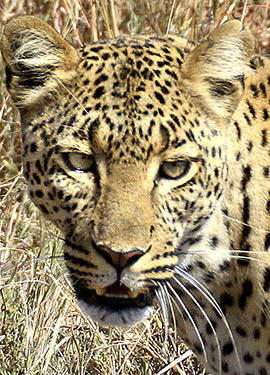 |
|
| |
|
|
Leopard Glamour. Serona area of the Serengeti |
|
| |
|
|
|
|
| |
We were 14 mostly amateur photographers on a photographic safari of Northern Tanzania in East Africa. Organized and led by one of the top wildlife photographers in the U.S., Todd Gustafson, we were assured of getting to the best locations to see the animals in the best light and at the best angles. The African drivers seemed to have super-sensory eyesight and could pick out a cheetah in the grass at 400 yards.
If we didn’t get great shots, it was strictly pilot error. |
|
| |
|
|
| |
 |
|
 |
|
| |
High as an Elephant's Eye. Tarangire National Park |
|
Vehicles gather where there is game to see. Tarangire River |
|
| |
|
|
|
|
| |
We photographed dozens of lion prides, all in varying behavioral situations, including kills, and carefree, playing cubs. We saw nine different cheetahs, including one race across the plains to take down a zebra; five leopards; countless elephants, including a charging matron in a family group with babies; tens of thousands of wildebeests and zebras; hyenas; jackals; song birds and vultures; hippos; a mother rhino with her teenage offspring; huge herds of grouchy cape buffalo; mongoose; a bat-eared fox and the ungainly yet graceful giraffes. Countless types of antelope, including the Dik-Dik—at 12-15 inches the smallest antelope in the world—scampered everywhere, while the big, impressive Elands look as if they were peeled off Paleolithic cave walls. |
|
| |
|
|
| |
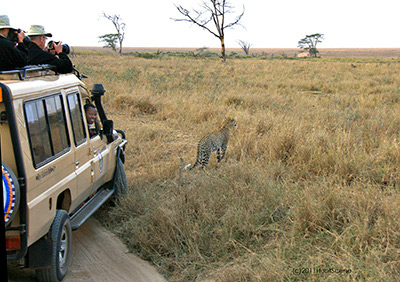 |
|
 |
|
| |
Animals have grown up with vehicles and, therefore, pay little or no attention to them. |
|
Bull Eland, largest of African antelopes. Lobo area of Serengeti |
|
| |
|
|
|
|
| |
The game in Tarangarie, Ngorongoro Crater and the southern Serengeti game reserves have grown up with vehicles driving by with strange, pale two-leggeds peering out from the roof, so our presence didn’t bother them, as long as we kept a respectful distance. At times I felt like I was on a movie set with the animals all playing their bit or starring roles. One cheetah nonchalantly walked among our vehicles, curiously pawing and sniffing our spare tire; a leopard slowly strolled within petting distance alongside my vehicle. |
|
| |
|
|
| |
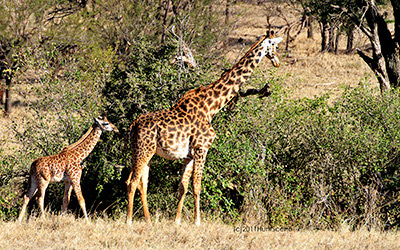 |
|
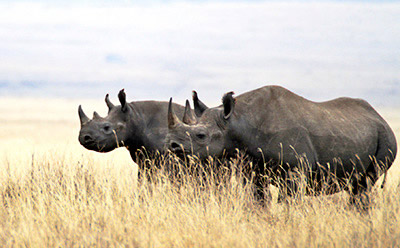 |
|
| |
Mama Giraffe and baby. Giraffes are silent, they have no vocal chords. |
|
Mother and teenager Black Rhinoceros, Ngorngoro Crater |
|
| |
|
|
|
|
| |
Looking out across the vast, flat plains, the impression is a peaceable kingdom, with thousands of herbivores feasting on the grass and Acacia trees. But predators have to eat, too, and the reality of life in the wild hits home. A lioness killed a wildebeest at the side of the road, snuffing out its life with her powerful jaws not five feet from us. We saw a pack of hyenas take a zebra kill away from a panting cheetah; two massive bull elephants fought for territory; two giraffe doing a slow, graceful fight to unbalance the other; even two male ostriches warred for the same lady. |
|
| |
|
|
| |
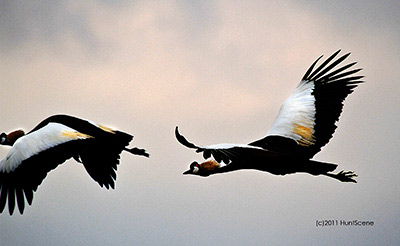 |
|
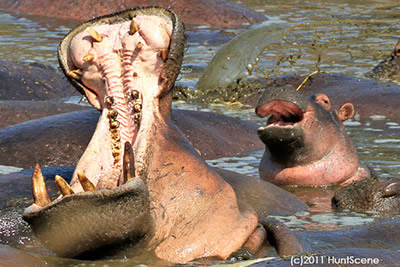 |
|
| |
Crown Cranes in Flight, Ngorngoro Crater |
|
Adult and baby hippopotamus yawn. Hundreds crowd together in the Hippo Pool, Serengeti. |
|
| |
|
|
|
|
| |
As dry and dusty as the Serengeti is, there are always springs bubbling up, providing a green oasis of tall grass and cool water. Here the hippos lounge with birds and baboons and everybody comes to drink.
The further north we traveled toward the Mara River dividing Tanzania and Kenya, the tourists became fewer and the game became more wary. We still were able to get so close to two male lions that their heads more than filled my camera frame using my short lens. Three cheetah brothers were trying to nap in the shade of a tree while we kept moving the vehicle by a few feet to get the best angle. They would get up, look disdainfully at us (as only a cat can), find a new place and throw themselves on the ground in exasperation that we were still there. |
|
| |
|
|
| |
 |
|
| |
Three Cheetah Brothers, we disturbed their afternoon nap. Northern Serengeti. |
|
| |
|
|
| |
The rich and fertile high-altitude Ngorongoro Crater is one of the greatest natural wonders of the planet. In fact, it is a UNESCO World Heritage Site. Most of the 300,000 or so of the animals here tend not migrate with the exception of the literally millions of wildebeest that cross the 12 miles of the crater floor, resulting in the densest concentration of wildlife in Africa. Food is plentiful with a variety of habitats and is it one of the few places the Black Rhino is thriving. Only giraffe and impala are missing from the scene. |
|
| |
|
|
| |
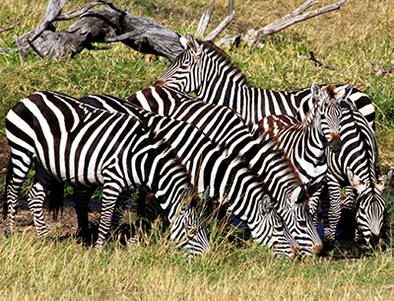 |
|
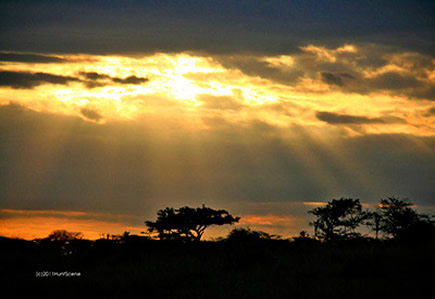 |
|
| |
Zebra family with yearling colt. Northern Serengeti |
|
Typical Tanzanian sunset |
|
| |
|
|
|
|
| |
|
|
|
|
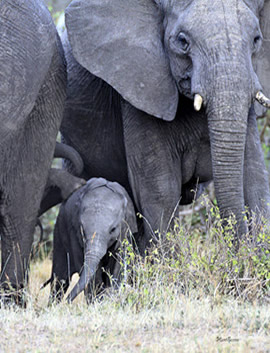 |
|
| |
Charging Bush Telephones. Solar powered, satellite connection. |
|
Maasai Traditional Jump Dance, Maasai Village, Ngorngoro Conservation Area |
|
Elephant Baby |
|
| |
Descending through the morning mist at the 8,000 foot crater rim down 2,000 feet into the collapsed caldera is like being reeled back in time. Dawn dissipated the fog, revealing what seemed to be the original Garden of Eden. The sun soon started to warm what felt like being in a deep freeze in the darkness. |
|
| |
|
|
| |
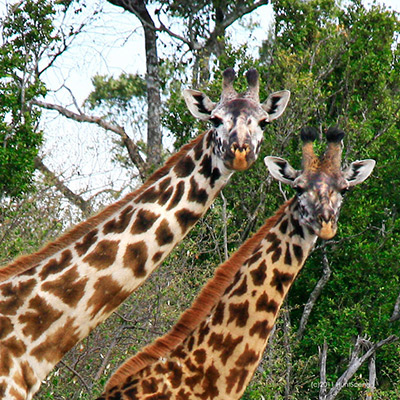 |
|
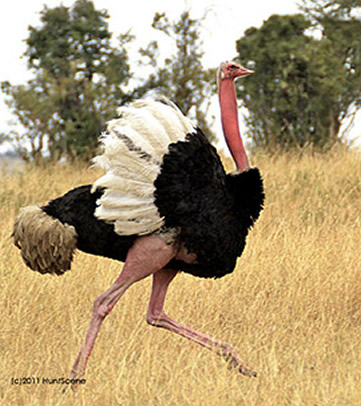 |
|
| |
Mr. and Mrs. Giraffe |
|
Male Ostrich. Red neck, fluffed feathers shows he is ready for breeding to his nearby girlfriend. |
|
| |
|
|
|
|
| |
Why Book with Todd?
Unlike a big tour company, Todd is über hands on. His father taught at a mission school in Tanzania where Todd grew up. He knows the animals, the people, the terrain. Now based in the Chicago area, over the last 20 years Todd has made 30 trips to Tanzania escorting over 300 people. He does things a bit differently from the big tour companies in that he looks at people’s personalities, interests and abilities to match them with each other and the drivers. Local tour operator, Roy Safaris, supplies the vehicles and drivers.
“I understand the African experience, and to know how to go with the flow,” he explained. “I also work hard to have people succeed. I’ll give personal instruction, whatever is needed. Besides, my trips are different,” he smiled, “because this is my backyard.”
You can book through a large commercial tour operator or you can set up your own journey if you do not want to go with a group. There are over 100 tour operators in Arusha, where most of them are based, which can arrange your trip. It’s a good idea to have enough people in your private group to have more than one vehicle. In case something happens, you have a back up driver and a lifeline to assistance. (www.Tanzaniatouristboard.com) |
|
| |
|
|
| |
 |
|
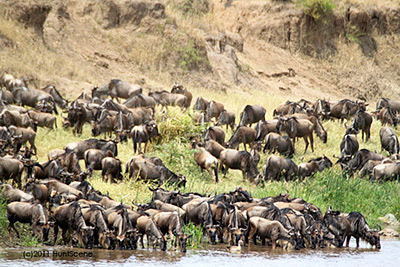 |
|
| |
Lioness with this year's cubs. Lobo district, Northern Serengeti |
|
Wildebeest gather at the Mara River, not quite ready to cross into Kenya. Crocodiles and hippopotamus are waiting for their dinner |
|
| |
|
|
|
|
| |
About Tanzania
Tanzania probably is one of the oldest known inhabited areas on Earth. Fossil remains of humans and pre-human hominids have been found dating back over two million years.
Ngorngoro Conservation Area protects Olduvai Gorge, long considered the seat of humanity after the discovery in the 1950s of the earliest known specimens of the human genus by Mary and Louis Leakey. The gorge is a steep-sided ravine in the Great Rift Valley which stretches along eastern Africa for 30 miles. It is one of the most important prehistoric sites in the world and research here has been instrumental in furthering our understanding of early human evolution.
Excavation work continues today by the Leakey family. Standing at the edge of the Olduvai site listening to the professor’s talk about the archeological work, I looked out over the enormous gorge and saw two Maasai herdsmen, tiny in the distance, walking across the expanse with their spears and distinctive red blankets carried over their shoulders. The scene could have been from hundreds of thousands of years ago and it gave me the chills.
The post–World War I accords and the League of Nations charter designated Tanganyika a British Mandate except for a small area in the northwest, which was ceded to Belgium. That area later became Rwanda and Burundi.
British rule came to an end in 1961 after a relatively peaceful transition to independence. Tanganyika combined with the island of Zanzibar to form Tanzania. The first president, Julius Nyerere, wisely overcame tribal differences by emphasizing national unity, making Swahili the unifying language of the country and English providing a way to participate in the global economy and culture. Tanzania today is peaceful and while there certainly is poverty by Western standards, it is a comfortable and safe place to visit.
After two weeks of rising before dawn, two game drives a day and seeing more animals than I could count, there always was something new. Just when I thought I had seen it all, we’d come upon a unique interaction not even Todd had witnessed before. The animals still dance in my head, months later. I find myself day dreaming about the primal feeling I got from standing in the middle of the endless high plains of East Africa. |
|
| |
|
|
| |
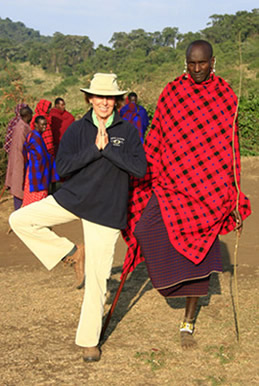 |
|
| |
Author in Tree Pose with Maasai Warrior. Maasai Village in Ngorngoro Conservation Area. |
|
| |
|
|
| |
Recommended reading:
A Photographer’s Guide to the Safari Experience by Todd Gustafson
Serengeti: The Eternal Beginning by Boyd Norton
Cocktail Hour Under the Tree of Forgetfulness by Alexandra Fuller.
Todd Gustafson Photo Safaris www.gustafsonphotosafari.net gustaphoto@aol.com
NOTE: The two times of year to go on a Tanzanian safari is June, July and August during long dry season after long rainy season, a time of great migrations. January, February is the short, hot dry season following the short rains, the time when the animals are giving birth.
For more photos, go to Picasa Web Album.com/Diana Hunt/Tanzania. |
|
| |
|
|
|
|
|


